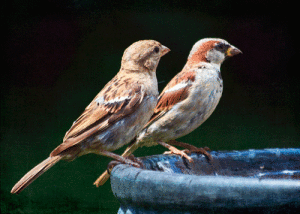
Male and Female House Sparrows
Most people have a pretty surprised reaction when they learn that not only are (almost all) birds protected by laws, but you can’t even pick up and take a feather you find on the ground. It’s one of those over protective laws that were created to make sure someone could not lie their way out of a fine. Almost all birds are protected by the Migratory Bird Treaty Act (MBTE), federal and state hunting regulations, or some other law like the Eagle Feather Law. There are very few exceptions but let’s talk about those in a bit.
Let’s say Bob is pulled over by the game warden. There is a dead owl laying in the bed of his pickup truck. Bob found it dead on the road and though he’d like to show it to his kids. Now comes the dilemma of how does the game warden prove that Bob didn’t shoot and kill the owl for the use of its feathers or to make a display mount of it. It’s going to be Bob’s word against the game warden. So the laws were made to not allow anyone (without both a state and federal permit) to keep a dead bird or any parts of it. Solves the issue.
The description of the MBTA goes as far as stating: “The statute makes it unlawful (without a waiver) to pursue, harass, hunt, take, capture, kill or sell birds listed therein. The statute does not discriminate between live or dead birds, and also grants full protection to any bird parts including feathers, as well as eggs and nests.” That pretty much covers it all!
So are there any birds not covered by these laws? Only a very few. They are the birds that are considered to be exotic introductions that have established themselves here in the wild. They include the House Sparrow, the European Starling, and the Rock Pigeon. All of these were brought from Europe by English colonists at some point in the 17th century. When the colonists arrived here some missed having a few of their bird species from home, and brought over cages full of them and let them go. From there they slowly spread across the whole continent.
Today the House Sparrows are doing better here than they are back in Europe where they have been declining in numbers for years. Both the House Sparrow and the European Starling have populated this continent in huge numbers and are a threat to native birds such as the Purple Martins whose young they kill and then take over their nests. Rock Pigeons may not be as big of a threat to other species, but are well known for the “whitewash” they decorate our city statues with! When we meddle with nature, we don’t normally do well.
Martin Hagne is the Executive Director of the Gulf Coast Bird Observatory. The GCBO is a non-profit organization dedicated to saving the birds and their habitats along the entire Gulf Coast, and beyond into their Central and South America wintering grounds.
